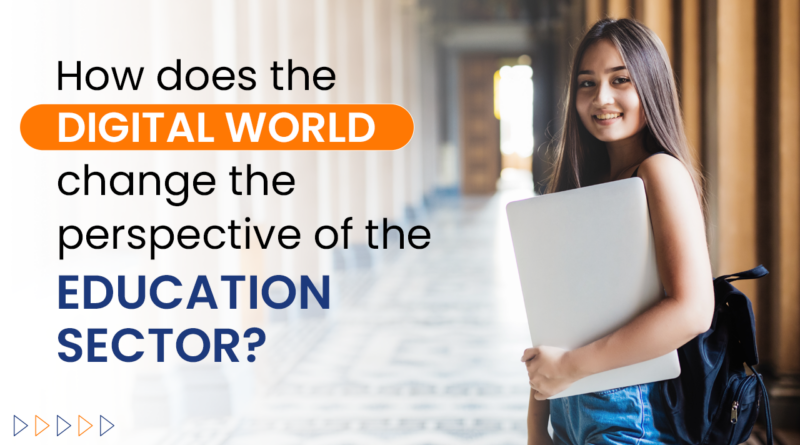How does the digital world change the perspective of the educational sector?
Digitalization of education refers to the integration of technology into the educational process. It involves the use of digital tools, such as computers, tablets, and smartphones, to enhance the learning experience. The digitalization of education has been on the rise for several years now, with the development of new technologies and the increasing availability of digital devices.
Digitalization of education has been one of the greatest transformations to take place in recent times. Digitalization holds immense potential for learning and knowledge sharing and brings new aspects to educational institutions worldwide, changing their perspective entirely. In this article, we will analyze how the digital world is changing the approach toward education and its effects on today’s society in general.
The Emergence of Online Learning / E-learning
With technology now has become so influential in our lives, it should come as no surprise that online learning has taken the worldwide market as one of its most rapidly progressing mediums of education system enhancement. It is used to provide a whole range of courses, anything ranging from business strategies to martial arts – even doctorates are being offered by many universities today through an online set-up. One huge advantage of this process compared to traditional college or university studies is that virtually anyone in any location can have access to information right away without having to leave their houses – or even their own countries depending on what they are studying! By using various multimedia techniques such as videos, audio-conferencing, and seminars combined with interactive learning techniques like problem-solving and gaming, concepts can be thoroughly illustrated with ease while also eliminating spatial boundaries across entire continents.
Impact on Traditional Classroom Learning
The impact eLearning has had in traditional classroom settings has been tremendous in relation to both teaching aids and classroom ambience alike! In many classrooms with limited resources due to financial constraints, modern technologies like tablets and projectors have allowed students access to limitless sources at the touch of a button, helping them gain further insight into concepts compared to when textbooks were far too expensive for certain schools. Even teachers now no longer need boards filled with chalk which creates a lot more dust than necessary, but can instead use digital Smart Boards where information is displayed faster and easier! Even tasks such as grading exams have become much easier for instructors today who now only need to submit grades onto spreadsheets at home for quicker result processing.
The impact of digitalization of education on learners
The impact of digitalization of education on learners has been immense. Digital tools have made learning more engaging, interactive, and accessible. With the use of digital devices, learners can access educational content from anywhere, at any time. This has made education more flexible, allowing learners to study at their own pace and according to their own schedule.
Digital tools have also made learning more interactive. With the use of multimedia content, such as videos, images, and animations, learners can engage with the content in a more meaningful way. Digital tools can also provide learners with instant feedback, helping them to identify areas where they need to improve.
The impact of digitalization of education on educators
The impact of digitalization of education on educators has been equally significant. Digital tools have made it easier for educators to create and deliver educational content. With the use of digital devices, educators can create multimedia content, such as videos, animations, and interactive simulations, to enhance the learning experience.
Apps To Support Education
Many innovative apps are being created around education today as well, games that teach algebraic functions while still increasing motivation among kids all while providing entertainment through rewards systems, quiz focused apps that allow instantaneous feedback all these graphical user interfaces make an otherwise daunting task seem fun where technology leverages learning significantly!
Whether it’s flashcards or even animators allowing an interactive way of breaking down complex problems and making them comprehensible by anyone anywhere is disrupting education format globally.
Electronic Learning Materials (ELMs)
A great benefit brought about by digitising content is making it available in multiple formats across various devices as opposed to mass-produced printed books which would challenge individuals having varying physical impairments due diligence is given towards accommodating student needs no matter which region they link from. Amongst companies competing respectfully here some trends are growing particularly faster, mEducator looks towards developing ELMs where lecturers can share video assignments via YouTube channel monitor student progress over smartphones and get analytical data about students’ performance outcomes fast yet accurately.
Conclusion
In conclusion, the digitalization of education has brought about unprecedented changes in the way education is delivered and accessed. In India, the digitalization of education faces several challenges, such as the lack of infrastructure, the digital divide, and the need for training. However, with the support of government initiatives and the growing demand for digital education, the future of digitalization of education in India looks promising. As technology continues to evolve, the educational sector in India will continue to transform, creating new opportunities for learners and educators alike.
Frequently Asked Questions (FAQs)
Q1: What challenges does digitalization of education face?
Answer: Some challenges of digitalization of education include the need for adequate infrastructure and technology, ensuring equitable access to digital resources, providing training and support for educators and learners, and addressing issues related to online privacy and security.
Q2: What impact has the COVID-19 pandemic had on the digitalization of education?
Answer: The COVID-19 pandemic has accelerated the adoption of digital tools and technologies in education, as many schools and institutions have had to switch to online learning. This has highlighted the importance of the digitalization of education and has led to a greater emphasis on digital skills and literacy.
Q3: What role do digital credentials and micro-credentials play in the digitalization of education?
Answer: Digital credentials and micro-credentials are digital badges that recognize specific skills or knowledge, and can be earned through online courses or other learning experiences. They provide learners with a more flexible and personalised way to demonstrate their skills and knowledge and enable employers to more easily identify and verify the skills of potential employees.
Q4: How do the use of artificial intelligence and machine learning impact the digitalization of education?
Answer: The use of artificial intelligence and machine learning in education enables personalised learning and provides more targeted feedback to learners. These technologies are likely to become more sophisticated in the coming years, and could help to transform the way education is delivered and assessed.




